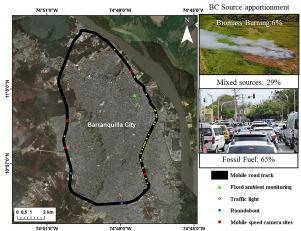Geoscience Frontiers ( IF 8.9 ) Pub Date : 2021-01-23 , DOI: 10.1016/j.gsf.2021.101149 Erika P. Blanco-Donado , Ismael L. Schneider , Paulo Artaxo , Jesus Lozano-Osorio , Luana Portz , Marcos L.S. Oliveira

|
Black carbon (BC) is one of the short-lived air pollutants that contributes significantly to aerosol radiative forcing and global climate change. It is emitted by the incomplete combustion of fossil fuels, biofuels, and biomass. Urban environments are quite complex and thus, the use of mobile jointly with fixed monitoring provides a better understanding of the dynamics of BC distribution in such areas. The present study addresses the measurement of BC concentration using real-time mobile and ambient monitoring in Barranquilla, an industrialized urban area of the Colombian Caribbean. A microaethalometer (MA200) and an aethalometer (AE33) were used for measuring the BC concentration. The absorption Ångström exponent (AAE) values were determined for the study area, for identifying the BC emission sources. The results of the ambient sampling show that vehicle traffic emissions prevail; however, the influence of biomass burning was also observed. The mean ambient BC concentration was found to be 1.04 ± 1.03 μg/m3 and varied between 0.5 and 4.0 μg/m3. From the mobile measurements obtained in real traffic conditions on the road, a much higher average value of 16.1 ± 16.5 μg/m3 was measured. Many parts of the city showed BC concentrations higher than 20 μg/m3. The spatial distribution of BC concentration shows that vehicle emissions and traffic jams, a consequence of road and transport infrastructure, are the factors that most affect the BC concentration. A comparison of results obtained from two aethalometers indicates that the concentrations measured by MA200 are 9% lower than those measured by AE33. The AAE obtained was found to vary between 1.1 and 1.6, indicating vehicular emissions as the most crucial source. In addition, it was observed that the BC concentration on working days was 2.5 times higher than on the weekends in the case of mobile monitoring and 1.5 times higher in the case of ambient monitoring.
中文翻译:

黑碳的来源识别和全球影响
黑碳 (BC) 是一种短寿命空气污染物,对气溶胶辐射强迫和全球气候变化有显着影响。它是由化石燃料、生物燃料和生物质的不完全燃烧而排放的。城市环境相当复杂,因此,结合使用移动和固定监测可以更好地了解这些地区的 BC 分布动态。本研究解决了使用实时移动和环境监测在哥伦比亚加勒比地区的工业化城市巴兰基亚测量 BC 浓度的问题。微量浓度计(MA200)和浓度计(AE33)用于测量BC浓度。确定研究区域的吸收 Ångström 指数 (AAE) 值,以识别 BC 排放源。环境采样结果显示,机动车交通排放占主导;然而,也观察到生物质燃烧的影响。发现平均环境 BC 浓度为 1.04 ± 1.03 μg/m3并且在 0.5 和 4.0 μg/m 3之间变化。根据在道路上的实际交通条件下获得的移动测量结果,测得的平均值要高得多,为 16.1 ± 16.5 μg/m 3。该市许多地区的 BC 浓度高于 20 μg/m 3. BC 浓度的空间分布表明,道路和交通基础设施导致的车辆排放和交通拥堵是影响 BC 浓度的最大因素。从两个风量计获得的结果的比较表明,MA200 测量的浓度比 AE33 测量的浓度低 9%。发现获得的 AAE 在 1.1 和 1.6 之间变化,表明车辆排放是最重要的来源。此外,据观察,移动监测的工作日BC浓度比周末高2.5倍,环境监测高1.5倍。



























 京公网安备 11010802027423号
京公网安备 11010802027423号